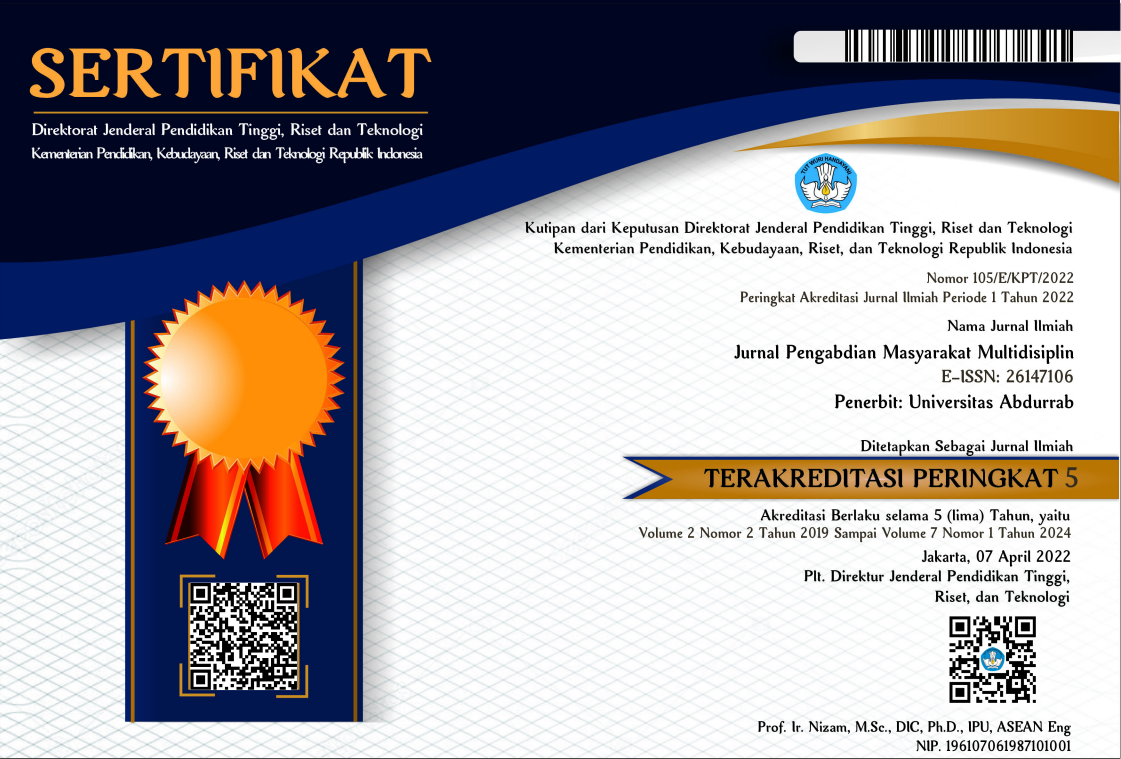DETEKSI DINI TERKAIT FLAT FOOT DI KB-TK AL-QURAN TERPADU BINTANGKU SURAKARTA
Abstract
Early age is the age when the pattern of growth and development is very rapid. This must be accompanied by proper education regarding growth and development, otherwise at this age the child will be susceptible to abnormalities. These disorders can be in the form of gait disorders. One of the most important parts that affect the biomechanical and musculoskeletal structures of the foot is the arch of the foot or arcus pedis. The consequences of an arch that does not grow normally include balance disorders, fatigue when walking for a long time, continuing deformity, and pain. Flat foot is the most common deformity or deformity of the foot in children. The activity was carried out at the TK-KB Al-Quran Terpadu Bintangku Surakarta school with a total of 60 children. The purpose of this activity is to see the prevalence of flat foot and preventive measures are delivered in the form of early detection using the Clarke's angle test. This program was carried out in May 2022. The results of this activity had a good impact in helping to increase children's knowledge about flat foot and it was found that the prevalence of cases was mostly experienced by males than females. The author hopes that schools can continue to routinely check flat foot activities considering that flat feet often do not cause symptoms, so early age screening is needed.
References
Antara, K. A., Adiputra, I. N., & Sugiritama, I. W. (2017). The Correlation Between Flat Foot with Static and Dynamic Balance in Elementary School Children 4 Tonja Denpasar City. Majalah Ilmiah Fisioterapi Indonesia, 5(3), 23–26. https://doi.org/https://doi.org/10.24843/MIFI.2017.v05.i03.p05
Indardi, N. (2015). Latihan Fleksi Telapak Kaki Tanpa Kinesio Taping Dan Mengunakan Kinesio Taping Terhadap Keseimbangan Pada Fleksibel Flat Foot. Journal of Physical Education Health and Sport, 2(2), 89–93.
Dewi, K. G. P., Dewi, A. A. N. T. N., Antari, N. K. A. J., & Indrayani, A. W. (2020). Perbedaan Gait Parameter Terhadap Tipe Arkus Pedis (Normal Foot, Flat Foot, dan Cavus Foot) pada Anak Sekolah Dasar Usia 10-12 Tahun di Denpasar Barat. Majalah Ilmiah Fisioterapi Indonesia, 8(2), 57–61. https://doi.org/https://doi.org/10.24843/MIFI.2020.v08.i02.p11
Nugroho, A. S., & Nurulita, F. F. (2019). Hubungan Antara Pes Planus Dengan Keseimbangan Dinamis Pada Murid MI Nurul Karim Colomadu. Jurnal Keterapian Fisik, 4(1), 6–14. https://doi.org/10.37341/jkf.v4i1.120
Bachtiar, F. (2012). Gambaran Bentuk Arkus Pedis Pada Mahasiswa Fisioterapi UNHAS Makassar [Universitas Pembangunan Nasional “Veteran” Jakarta]. https://doi.org/10.13140/RG.2.2.13601.33126
Hillstrom, H., Song, J., Kraszewski, A., Hafer, J., Mootanah, R., Dufour, A., Chow, B., & Deland, J. (2013). Foot Type Biomechanics Part 1: Structure and Function of The Asymptomatic Foot. Gait and Posture, 37(5), 445–451. https://doi.org/10.1016/j.gaitpost.2012.09.007
Mien, V. A., Mayasari, W., & Chaidir, M. R. (2017). Gambaran Faktor Risiko Flat foot pada Anak Umur Enam sampai Sepuluh Tahun di Kecamatan Sukajadi. Jurnal Sistem Kesehatan, 3(2), 97–102. https://doi.org/10.24198/jsk.v3i2.15010
Chen, K., Tung, L., Tung, C., Yeh, C., Yang, J., & Wang, C. (2014). Research in Developmental Disabilities An investigation of the Factors Affecting flat foot in children with delayed motor development. Research in Developmental Disabilities, 35(3), 639–645. https://doi.org/10.1016/j.ridd.2013.12.012
Maharani, A. A. A. A., Wibawa, A., & Adiputra, I. N. (2020). Perbedaan Kelincahan Antara Normal Foot Dan Flat foot Pada Anak Usia 10-12. Majalah Ilmiah Fisioterapi Indonesia, 8(3), 7. https://doi.org/10.24843/mifi.2020.v08.i03.p05
Hegazy, F., Aboelnasr, E., Abuzaid, M., Kim, I. J., & Salem, Y. (2021). Comparing Validity and Diagnostic Accuracy of Clarke’s Angle and Foot Posture Index-6 To Determine Flexible Flat foot In Adolescents: A Cross-Sectional Investigation. Journal of Multidisciplinary Healthcare, 14(August), 2705–2717. https://doi.org/10.2147/JMDH.S317439
Pita-Fernández, S., González-Martín, C., Seoane-Pillado, T., López-Calviño, B., Pértega-Díaz, S., & Gil-Guillén, V. (2015). Validity Of Footprint Analysis To Determine Flat foot Using Clinical Diagnosis As The Gold Standard In A Random Sample Aged 40 Years And Older. Journal of Epidemiology, 25. https://pubmed.ncbi.nlm.nih.gov/25382154/
Latifah, Y., Naufal, A. F., Nafi’ah, D., & Astari, R. W. (2021). Hubungan Antara Postur Flat foot Dengan Keseimbangan Statis Pada Anak Usia 12 Tahun. FISIOMU: Physiotherapy Evidences, 2(1), 1–6. https://doi.org/10.23917/fisiomu.v2i1.10039
Pristianto, A., Susilo, T. E., & Setiyaningsih, R. (2018). Penerapan Functional Movement Screening (FMS) untuk Pencegahan Cidera Olahraga pada Komunitas Kalistenik Solo. The 8th University Research Colloquium 2018 Universitas Muhammadiyah Purwokerto, 267–271. http://repository.urecol.org/index.php/proceeding/article/view/350
Copyright (c) 2022 Jurnal Pengabdian Masyarakat Multidisiplin

This work is licensed under a Creative Commons Attribution-NonCommercial-ShareAlike 4.0 International License.
1. Copyright of all journal manuscripts is held by the Jurnal Pengabdian Masyarakat Multidisiplin.Formal legal provisions to access digital articles of electronic journal are subject to the provision of the Creative
2. Commons Attribution-ShareAlike license (CC BY-NC-SA), which means that Jurnal Pengabdian Masyarakat Multidisiplin is rightful to keep, transfer media/format, manage in the form of databases, maintain, and
3. publish articles.Published manuscripts both printed and electronic are open access for educational, research, and library purposes. Additionally, the editorial board is not responsible for any violations of copyright law.
licensed under a Creative Commons Attribution-ShareAlike 4.0 International License.
 PDF (Bahasa Indonesia)
PDF (Bahasa Indonesia)
 Abstract views: 350
Abstract views: 350
 downloads: 426
downloads: 426

 :
:




